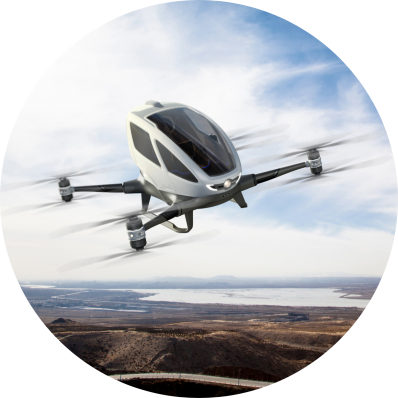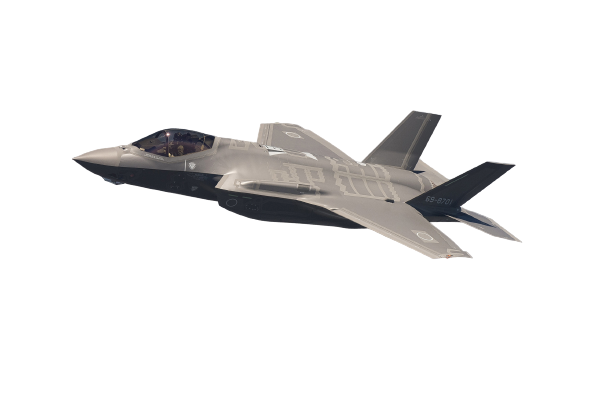Aerospace and Avionics Cooling
Thermal management is crucial when it comes to the reliable operation of semiconductors and electronic components in aviation, aerospace and military applications. Because avionics see a wide range of rugged environments such as freezing conditions, high humidity, sand and temperature extremes, keeping their operating temperatures within acceptable limits with flight-certified liquid coolants is a challenge. Microchannel liquid cooling can drastically improve the functionality, efficiency, dependability and safety of these electronics by most effectively managing thermal excursions where lives and mission success depend on it.
Thermal Management for Traditional Aircraft and Electric Air Mobility
One of the primary design goals for aircraft and emerging electric air mobility vehicles is efficient energy usage. The waste heat produced by avionics systems must therefore be managed by the least energy input necessary, so that power can be conserved for primary aircraft functions. Mikros’ Microchannel liquid cooling design provides the highest heat transfer rates among competing solutions with extraordinarily low coolant flow rates. This means smaller, lighter and more cost-effective cooling systems can be designed, not only in the cold plate heat transfer mechanism itself but also in the pumps and peripheral components needed to distribute coolant.

Cooling of Modern Aircraft
Optimized avionics thermal management designs for avionics are critical to the design and functionality of modern aircraft due to high heat loads, temperature sensitivity of composite materials and the architecture of aircraft electrical systems. Liquid and air cooling systems are both vital for the removal of waste heat, which can impact fuel consumption and overall aircraft efficiency. As avionics continue to increase in complexity and perform more challenging tasks in machine learning and artificial intelligence, keeping the semiconductors and communication components within operating temperature limits is increasingly critical.
Nearly all modern aircraft rely on highly effective thermal management for their control systems to operate reliably. Each can benefit from the implementation of a Mikros microchannel cooling aproach.
- Commercial jets and helicopters.
- Military manned combat aircraft.
- Unmanned Aircraft.
- Electric air mobility vehicles (eVTOL).
- Electric hybrid vehicles.
Air Cooling Systems
Air cooling of electronics is common for lower power components producing lower heat flux (W/cm2). Attaching a conductive, finned heat sink and utilizing airflow to cool is economical and easy to implement. Aircraft in flight sometimes have the advantage of using colder external air for convective heat transfer, decreasing the coolant temperature and thus increasing cooling performance at a fixed area and flow rate.
Air Cooling Limitations
Though air cooling systems are economical, they also have limitations:
- Limited thermal performance: The lower specific heat, or heat-carrying capacity, of air means that air cooling has quickly diminishing returns on cooling capacity, requiring higher cost and larger components for less gain in effectiveness. At a certain power level, often below that of modern control components, airflow simply can’t remove the heat fast enough, causing components to overheat.
- Higher pressure drop: As a compressible fluid, air pressure is lower than liquid pressure for a given mass flow rate. However, the lower heat transfer rate of air heat sinks require a lot of surface area to dissipate, increasing mesh densities and increasing pressure drops for the system. On a large scale, this consumes more energy, space and cost for a marginally effective cooling solution.
- Impractical solutions: Forced-air convection for cooling high power devices can also require larger fans that require more power, generate more noise and vibration and present a new failure mode for a system.
Liquid Cooling Method for Avionics
Liquid cooling of avionics requires system investment but can remove heat quickly much more efficiently. Often, the liquids and cooling fluid components already used for aircraft operations at their in-flight temps can be used for additional avionics cooling. A Mikros microchannel cooling solution can be implemented within existing coolant routing structures to increase cooling capacity by multiple factors with little additional cost. The cooling capacity and energy efficiency of a Mikros solution is especially valuable in the avionics for aerospace and defense operations, which endure an enormous heat load to reach operating altitude and absorb high levels of radiation while in orbit.
An optimal aircraft design often includes liquid cooling systems to complement air cooling solutions, as each has a place in the cooling ecosystem. Liquid cooling can be expanded and improved with a Mikros microchannel solution as higher power components and higher temperature environments become part of new or evolving avionics designs.

Mikros Liquid Cooling Benefits
Liquid cooling with Mikros microchannels comes with a wide array of advantages for avionics thermal management:
- High thermal performance: Microchannel liquid cooling has orders of magnitude greater thermal effectiveness than air and conventional liquid cooling (W/C-cm2 – power dissipated per unit temperature rise over a given area)
- Lower Pressure drop: Liquid cooling achieves a more efficient pressure drop than air cooling systems.
- Space-saving: Mikros microchannel cooling solutions often take up a small fraction of the volume of conventional systems.
- Weight-savings: Mikros solutions can be constructed out of lower-density materials, with much less mass for advanced performance.
- Thermal Control: Mikros cooling systems can regulate flow rate to different areas of a heated surface, targeting more cooling to higher power regions.
- Sealed design: Mikros solutions are diffusion bonded in a sealed for leak-tight performance over the full temperature and pressure ranges for avionics applications.
Contact Us Today for an Advanced Avionics Cooling Solution
If you’re looking for thermal management systems for avionics, Mikros Technologies has the effective liquid cooling solutions you need. Contact us today to discuss how a high performance Mikros microchannel cooling solution can help your new avionics design achieve new heights of efficiency.